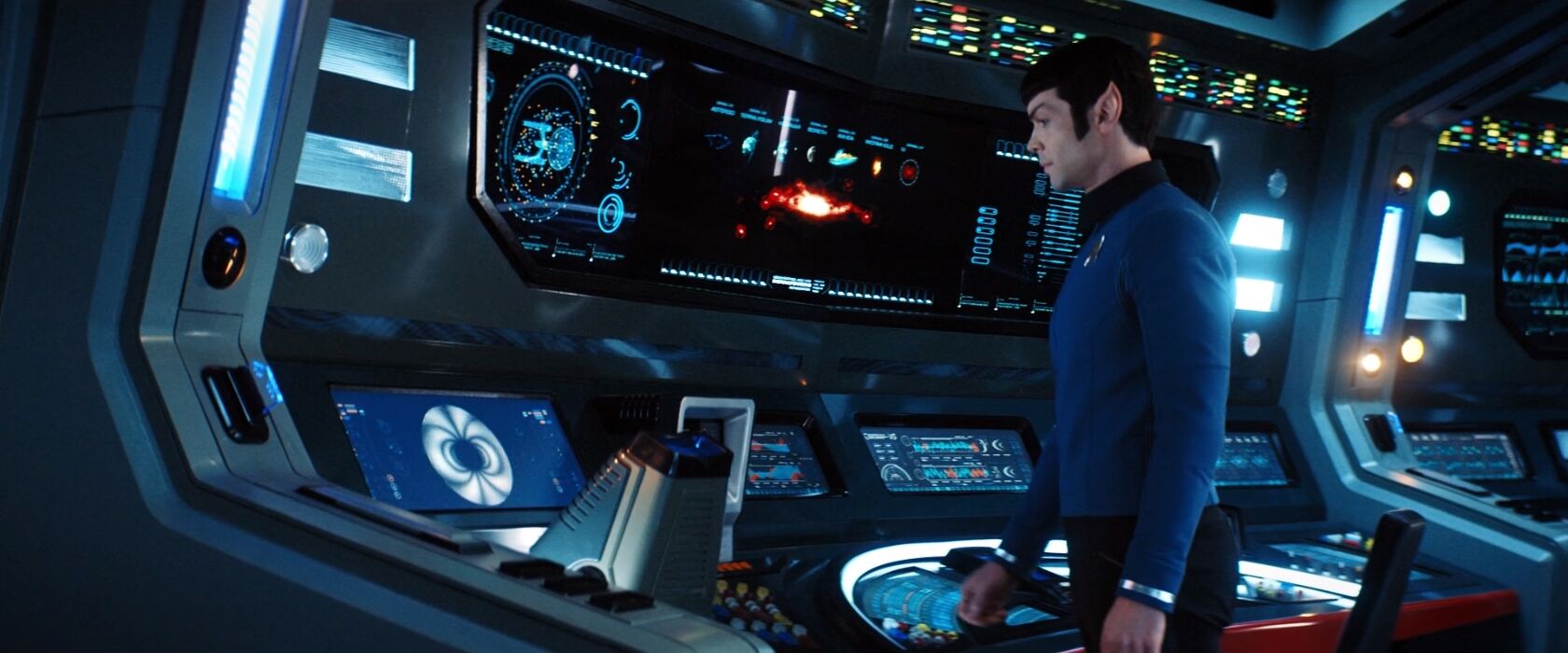A control panel, control interface, or simply interface, was a means by which a person operating a particular piece of equipment could instruct the device or system as to what they desired, and the item being controlled could respond accordingly. It was possible to combine elements of one or more of each type within an overall control system structure as alternative means of accessing the controls.
Control interfaces were commonly found on starships and space stations as part of console stations and were critical to how crewmembers interact with computer systems like LCARS and TCARS.
A control interface could also refer to parts of the physical circuitry found in computers and other machines. Exocomps had a control interface in their internal circuitry that relayed commands from a control PADD. (TNG: "The Quality of Life") Data told Geordi La Forge to try a bypass of the shield control interface in an attempt to override the effects of the Iconian software transmission. (TNG: "Contagion")
There were five major types of control interface available to most spacefaring species: physical, audio, touch sensitive, motion sensitive, and neural.
Physical

A physical control interface utilized physical buttons, switches, dials, and levers for data input purposes, and relied on physical indicators such as gauges, status lights, and visual screens/monitors for response purposes. Manipulation of a physical control was often accompanied by a visual or audio cue to indicate that the input had been accepted by the interface.
A major use for physical controls, even after the introduction of more "advanced" systems, was the operation of small equipment requiring only relatively simple commands, such as personal weapons, tricorders, and communicators. (Star Trek: The Original Series; Star Trek: The Next Generation)
Interfaces of this type were the primary ones utilized by Starfleet in the 22nd century, and continued to be prevalent in the Federation Starfleet well into the late 23rd century. (Star Trek: Enterprise; Star Trek: The Original Series)

Some people, such as Tom Paris, felt that physical control interfaces were superior to other forms of interface, particularly in flight control operations. The belief was that the operator had a better "feel" for the responsiveness of the system. (VOY: "Extreme Risk")
The large, round door leading to the secret listening post from inside the reliquary in the catacombs beneath the monastery at P'Jem had a small control panel with Vulcan writings which could be used to open the door. (ENT: "The Andorian Incident")
Audio
Audio control interfaces utilized spoken words or other transmitted sounds as both the primary means of data input and systems response, though response via other means could be requested by the operator. Twenty-third century computers made frequent use of audio interfaces, as did personal communicators, a trend which continued into the 24th century. (Star Trek: The Original Series; Star Trek: The Next Generation)
Touch-sensitive

Touch-sensitive interfaces typically consisted of featureless panels with no physical instruments to manipulate at all. The entire surface could be controlled by computer to display a layout of marked areas which served the same function when the surface detected contact from the user.
They were considered more "flexible" than physical interfaces, as the same physical unit could be rapidly reconfigured into whatever form a user might have required by calling up the appropriate control template.
Starfleet began deploying touch sensitive controls to vessels sometime prior to 2256, however, by 2265, they fell out of mainstream use. Starfleet began to to experiment with touch-sensitive interfaces again in the mid-2280s by incorporating them into the bridge of the prototype USS Excelsior. (Star Trek: Discovery, Star Trek III: The Search for Spock)
In the alternate reality, Starfleet incorporated touchscreen interfaces by 2258. (Star Trek)
J.J. Abrams commented here on giving the alternate USS Enterprise touchscreen panels that "Given what our computer interfaces are like now, its preposterous to assume that hundreds of years from now there won't be some version of holographic screens."
Motion-sensitive

Motion-sensitive interfaces were generally used to control simple mechanisms, such as pocket doors and lights. Some such interfaces could also be found on the bridge of the USS Enterprise in the mid-23rd century. (TOS: "The Cage", "Where No Man Has Gone Before")
In at least one alternate timeline, Starfleet began to use so-called "holographic" control interfaces on board their ships. Little is known about them, but given the 3D nature of a hologram, some sort of motion/position sensitive operating mechanism seems likely. (DS9: "The Visitor")
The temporal navigation console aboard the 29th century timeship USS Relativity utilized a combination of touch-sensitive and and motion-sensitive controls. An officer touched the screen for inputs and then motioned their hand to confirm those inputs. (VOY: "Relativity")
Neural

Neural interfaces directly transmitted commands from and information into the brain of the operator, thus bypassing the need to use comparatively inefficient physical manipulation of controls to complete a task.
In the 23rd century, Commander Spock's brain was stolen by an alien race and connected to a neural interface to coordinate the life support systems of their habitat. A more primitive form of interface was used to maintain and control his body until the brain could be restored to it. (TOS: "Spock's Brain")
Geordi La Forge used a VISOR to compensate for his blindness that contained Neural interfaces. He also participated in an experiment using a neural-interface-controlled remote probe. (TNG: "Interface")
Neural interfaces were frequently used in clandestine/criminal activities. (DS9: "Honor Among Thieves")
Alice had a neurogenic interface. (VOY: "Alice")
See also
- Atmospheric control panel
- Computer control panel
- Flight control interface
- Impulse system control panel
- Panel J14-Baker
- Shield control interface
- Temperature control panel
- Warp control panel